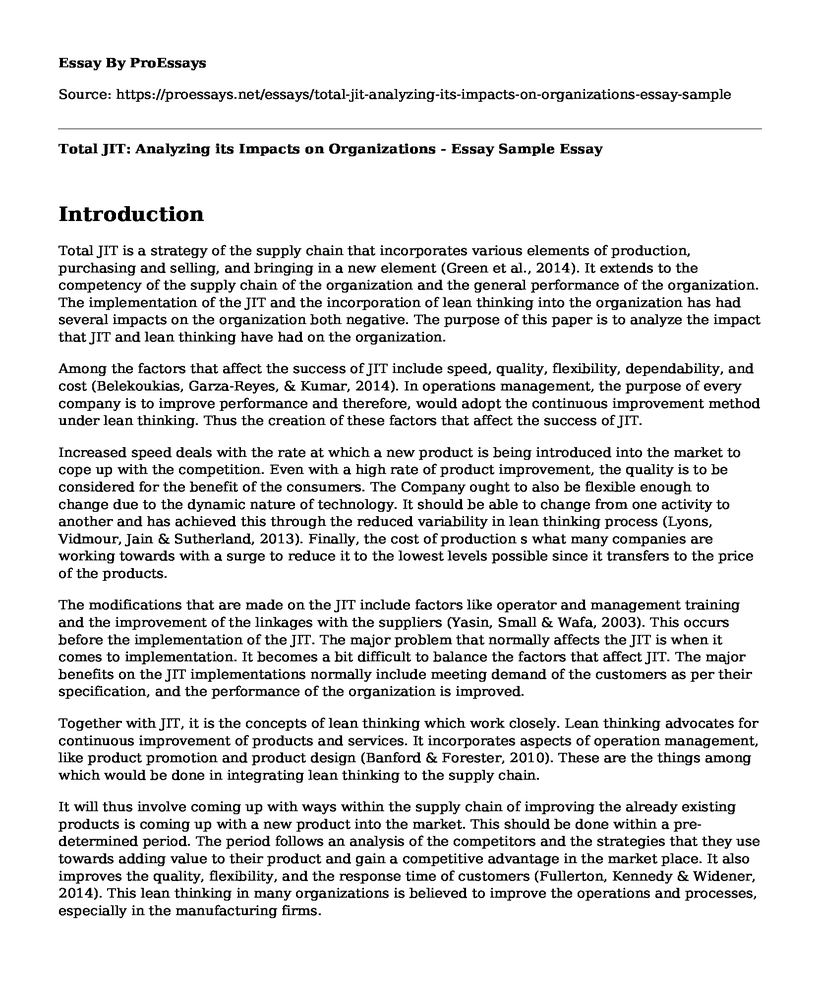Introduction
Total JIT is a strategy of the supply chain that incorporates various elements of production, purchasing and selling, and bringing in a new element (Green et al., 2014). It extends to the competency of the supply chain of the organization and the general performance of the organization. The implementation of the JIT and the incorporation of lean thinking into the organization has had several impacts on the organization both negative. The purpose of this paper is to analyze the impact that JIT and lean thinking have had on the organization.
Among the factors that affect the success of JIT include speed, quality, flexibility, dependability, and cost (Belekoukias, Garza-Reyes, & Kumar, 2014). In operations management, the purpose of every company is to improve performance and therefore, would adopt the continuous improvement method under lean thinking. Thus the creation of these factors that affect the success of JIT.
Increased speed deals with the rate at which a new product is being introduced into the market to cope up with the competition. Even with a high rate of product improvement, the quality is to be considered for the benefit of the consumers. The Company ought to also be flexible enough to change due to the dynamic nature of technology. It should be able to change from one activity to another and has achieved this through the reduced variability in lean thinking process (Lyons, Vidmour, Jain & Sutherland, 2013). Finally, the cost of production s what many companies are working towards with a surge to reduce it to the lowest levels possible since it transfers to the price of the products.
The modifications that are made on the JIT include factors like operator and management training and the improvement of the linkages with the suppliers (Yasin, Small & Wafa, 2003). This occurs before the implementation of the JIT. The major problem that normally affects the JIT is when it comes to implementation. It becomes a bit difficult to balance the factors that affect JIT. The major benefits on the JIT implementations normally include meeting demand of the customers as per their specification, and the performance of the organization is improved.
Together with JIT, it is the concepts of lean thinking which work closely. Lean thinking advocates for continuous improvement of products and services. It incorporates aspects of operation management, like product promotion and product design (Banford & Forester, 2010). These are the things among which would be done in integrating lean thinking to the supply chain.
It will thus involve coming up with ways within the supply chain of improving the already existing products is coming up with a new product into the market. This should be done within a pre-determined period. The period follows an analysis of the competitors and the strategies that they use towards adding value to their product and gain a competitive advantage in the market place. It also improves the quality, flexibility, and the response time of customers (Fullerton, Kennedy & Widener, 2014). This lean thinking in many organizations is believed to improve the operations and processes, especially in the manufacturing firms.
Conclusion
In conclusion, JIT and lean thinking generally work closely using their principles with the main aim of improving the general performance of the firm. The key aim of the two concepts is on cost, speed, flexibility, quality, and the dependability of operations in the organization. They work towards the satisfaction of the customers and the performance of the organization.
References
Bamford, D., & Forrester, P. (2010). Essential guide to operations management: concepts and case notes. John Wiley & Sons.
Belekoukias, I., Garza-Reyes, J. A., & Kumar, V. (2014). The impact of lean methods and tools on the operational performance of manufacturing organizations. International Journal of Production Research, 52(18), 5346-5366.
Fullerton, R. R., Kennedy, F. A., & Widener, S. K. (2014). Lean manufacturing and firm performance: The incremental contribution of lean management accounting practices. Journal of Operations Management, 32(7-8), 414-428.
Green, Jr, K. W., Inman, R. A., Birou, L. M., & Whitten, D. (2014). Total JIT (T-JIT) and its impact on supply chain competency and organizational performance. International Journal of Production Economics, 147, 125-135.
Lyons, A. C., Vidamour, K., Jain, R., & Sutherland, M. (2013). Developing an understanding of lean thinking in process industries. Production Planning & Control, 24(6), 475-494.
Yasin, M. M., Small, M. H., & Wafa, M. A. (2003). Organizational modifications to support JIT implementation in manufacturing and service operations. Omega, 31(3), 213-226.
Cite this page
Total JIT: Analyzing its Impacts on Organizations - Essay Sample. (2023, Jan 16). Retrieved from https://proessays.net/essays/total-jit-analyzing-its-impacts-on-organizations-essay-sample
If you are the original author of this essay and no longer wish to have it published on the ProEssays website, please click below to request its removal:
- Statement of Personal Leadership Vision
- Critical Thinking Essay Example on Business Forecasting
- Essay Example on Management of Hospitals
- Annotated Bibliography on Building Information Model
- Leadership Philosophy: Ethical Leadership and Decision Making Essay
- Ambush Marketing Essay Example
- Example on Methods for Stakeholders Registry and Analysis







